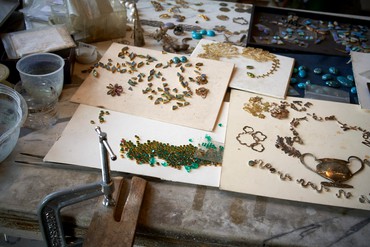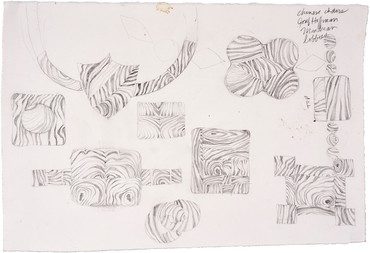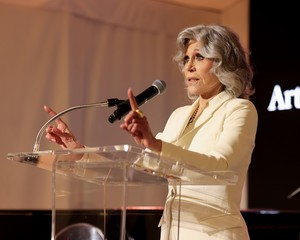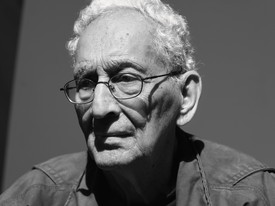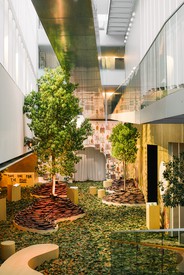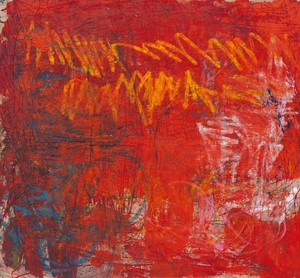
Wyatt Allgeier is a writer and an editor for Gagosian Quarterly. He lives and works in New York City.
Wyatt Allgeier I took a sneak peek around your studio and noticed a lot of literature and auction catalogues. I’m curious about your sources of inspiration.
Judy GeibI start from loving objects that are made by hand. I adore folk art and outsider art—they’re some of my favorite forms of art to look at. You said you saw works of literature. One of my recent jewelry series was based on Moby-Dick. I think the world is in that book. My series is more in awe of Herman Melville and the whale than it is about making any specific reference to the novel, but I do have a whale spouting vapor, specifically inspired by chapter 85. Melville loves the whale and its majesty, and considering everything going on now, he was amazingly prescient when he wrote his book in 1851.
Inspiration, for me, comes from a huge variety of sources—African textiles, agates, music, stones, patterns, Rorschach inkblots. I did a series based on photographs by James Welling, in which there were many circles next to each other. I love Piero Manzoni. It’s important for me, in my practice, to take a leap into the unknown.
WAAnd there seem to be architectural influences in your work as well.
JGI actually worked for an architect for my first fifteen years in New York—Peter Eisenman, the Deconstructivist architect. I did his graphic design. At the time, I felt like I knew everything that was going on with architecture because I was working in the hotbed. Rem Koolhaas, Frank Gehry, Arata Isozaki—everybody came to the office and the studio.
WAHow did your love for creating jewelry originate? Was there a particular moment or a particular stone or jewel or material that just called to you?
JGI was obsessed with antique jewelry. I’m not from a jewelry family and we didn’t have a big enough budget for it, so I realized that I was going to have to make it myself. I met an opal dealer and I bought two opals. From there, I went out and got a plumber’s torch and I bought a little silver and a little gold and I went for it.
WAEvery piece is unique and I’m sure that the process from sketch to fabrication is different for each one, but is there a general way in which you like to work?
JGAs you can see on my worktable, I tend to keep a lot of objects lying around in piles and then sometimes one of them just sparks something. In terms of drawing, I love calligraphy and incorporating it into my designs. For instance, I have a giant page of calligraphic marks from which I picked out my favorites and made a necklace. Another piece, Medieval Folklorish, came from drawing, as well. The idea is sometimes in a drawing and then I try to elaborate on it. But my process doesn’t always begin with sketches—mostly I just make. And sometimes drawing helps afterward, like for the agate pieces, to flesh out ideas or rule things out.
WAYour advertising campaign is really beautiful and involves a high level of collaboration. I’m curious to hear more about how, after the jewelry is made, you work with photographers and envision the public presentation.
JGIn my case, it’s straightforward and simple. I was introduced to the photographer Dirk Vandenberk about thirty years ago when I had just started making jewelry, and I’ve been working with him ever since. It started by chance, with Dirk, not knowing him that well, and it’s developed into a wonderfully fruitful partnership. Thanks to him, I not only have archives of all my work, but also lots of videos and playful explorations. He’s always game to experiment and brings something special to each image.
WAWe’ve covered the inspirations, we’ve covered the materials. What else do you have up your sleeve? What’s coming up next?
JGIn the covid era, I’m delving into labor with less overtly expensive materials. I was in Colombia last March and I bought hundreds of emeralds! I have tons of materials. But I want to try to cherish the labor part and have the end product be more modest. My whole aesthetic is humble extravagant; I’ve always wanted to make things that are wearable and not too precious. So this is consistent with my long-term practice, but now I want to pare down and be intentional: enjoy the labor, the making.
Photos: Dirk Vandenberk

